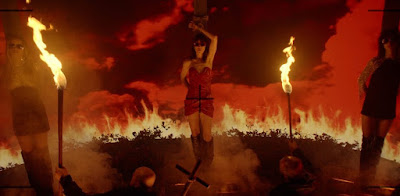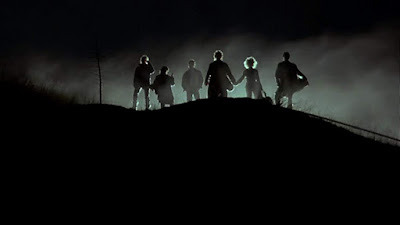What makes a horror film scary? I feel like this is a question that maybe isn’t wrestled with as much as it should be, given the amount of dreck that stops at “murder a lot of people in as messy a fashion as possible” and calls it a day. But to be fair, it’s not always easy to quantify what makes something really scary. Often it comes down to, for lack of a better word, vibes.
And sure, vibes don’t come out of nowhere, they’re a product of things like performance and mood and cinematography, but they’re ineffable in the sense that either you’ve got the vision and the way to see it realized or you don’t. If you don’t have a vision, the best you’re going to do is something competently produced that might get a few jolts out of people, but isn’t really scary. Vibes can go a long way toward making up for flaws, because unless it’s really egregious, I won’t remember bad filmmaking choices, but the creepy, haunting, unnerving stuff will stay with me for ages.
Longlegs - a bleak, deeply unnerving marriage between police procedural and occult nightmare - does fumble things a little, but as a vision it is so fully and confidently realized that you’re mostly too busy trying to crawl out of your skin to notice them in the moment. It is all about the vibes.
It’s the story of FBI agent Lee Harker. She’s withdrawn, odd to the point of being off-putting, but she’s also shown an unusual amount of insight into difficult cases. And right now, her insight is very much needed, because the FBI have a serial killer on their hands…well, that’s not exactly right. They have a number of crime scenes, where entire families have been brutally murdered, typically by the father. What’s giving law enforcement trouble is that at every scene, they find a letter written in some kind of code that they aren’t able to crack. No other physical evidence that anyone else has been there, just the letters.
And each letter is signed “Longlegs.”
The visuals are equally unsettling - the film is set in 1990s Oregon, and everything is gray and cloudy and damp, with traces of snow clinging here and there. Interiors are often dimly lit as well, though not to the point of being unreadable. This is a world where there’s just not a lot of light, and we move from the institutional strangeness of FBI headquarters (if you’re at all familiar with the very good game Control, it’s definitely giving The Oldest House in places) to crime scenes that suggest awful, awful things without ever really tipping their hands entirely, to the cramped, stifling home of Harker’s mother, a woman damaged by some past tragedy to the point of hoarding and agoraphobia. Even Harker’s own home, which should feel warm and cozy, just feels like a place where something awful is just waiting around the corner all of the time. It’s the unease of places that you know aren’t normal, of homes that aren’t home-like, of innocuous spaces late at night, when they should be empty but aren’t. This is not a film where anywhere ever feels safe. There are flashbacks to crime scenes smeared with blood, bodies under blankets and location markers, again giving us glimpses that only fuel our imaginations, all punctuated with title cards in stark black and red. There are very few shots with more than one person in the frame at once (and sometimes shots where the tops of heads are out of frame, which is especially disconcerting), creating a sense of isolation and disconnectedness, emphasizing the alien feel of the entire thing. It’s something of a slow burn, punctuated with sudden moments of terrible violence, arresting, surreal imagery, and grainy flashbacks to the 1970s that shrink the aspect ratio to a square, like home movies that you’re pretty sure nobody was ever meant to see.
So the vibes are doing a lot of heavy lifting here, and doing it admirably. That said, there are some places where it trips a little, mostly in the third act. It spends the first two setting up this really unsettling world, but there are some elements of the story that are maybe a little too easy to see coming from very early on, and others that really get sprung on the audience in the last act in what does amount to a bit of an exposition dump, albeit one that manages to sustain the atmosphere of the first two acts. There’s an element that’s important to how the killer is doing what he’s doing that gets introduced in the second act, but because the whole film feels so fucking weird already, its importance doesn’t really come across and when it’s brought back in the third act, it does feel like it’s coming out of nowhere. Finally, there’s one particular twist that was just convenient enough to leave a bit of a bad taste in my mouth, even though it was, once again, revealed in fine, striking fashion; something hidden and in plain sight the entire time.
The overall effect is, as I’ve said, like you’re watching a film with elements that you recognize and a story that you’re pretty sure you should be able to follow, but feels wrong somehow, as if whatever evil lurks in the story has managed to infect the film itself. It’s been getting a lot of (simplistic) comparisons to The Silence Of The Lambs, and if you’re looking for that kind of macabre crime procedural, this is not going to scratch that particular itch. But if you’re willing to immerse yourself in its nightmare logic, it’s one that will stay with you.
IMDB entry







